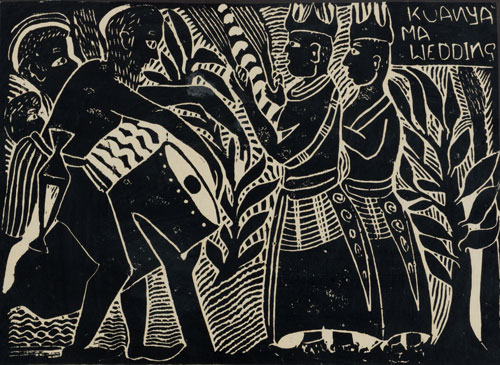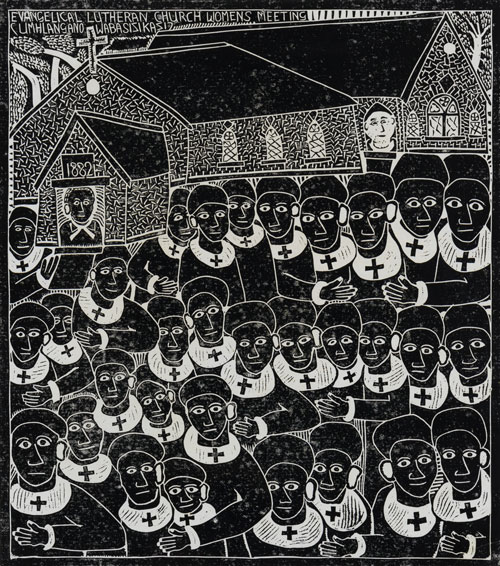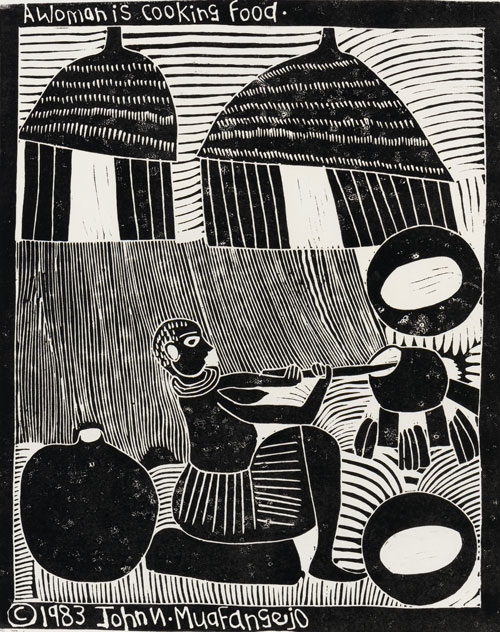Legendary printmaker John Muafengejo’s biggest individually owned body of work up for grabs at auction
Collectors have until Monday, May 3 to bid online for this museum quality work constituting 100 examples of the artist’s masterful linocut prints, as well as 36 original (but cancelled) lino blocks.
By Edward Tsumele

The odds were definitely staked against him, and it was a combination of factors that saw him prevail against what would have been obstacles that would have been un-surmountable obstacles for others to emerge as one of the most prominent visual art voices of his generation in southern Africa.
First of all he was black in a country in which black people did not have freedom (South West Africa then now Namibia after independence). Secondly he had to leave his own country to go to another country in order for him to be trained as an artist. Thirdly he had to get permission from the Department of Bantu Affairs in then apartheid ruled South Africa for him to travel out of what was then South West Africa, to come to South Africa .Fourthly he had to find a sponsor in the form of a person of good standing to motivate for him to be accepted at Rorke’s Drift as someone who had potential in art.
Fifthly, as ate would have it, he at one stage had to leave postpone classes when illness struck and he had to be hospitalized. Sixthly, he had to endure the humiliation of being interviewed by the University of Cape Town for admission that was not admission, for being black prevented him from taking his place at UCT among other students studying art.

Clearly these obstacles could have easily discouraged a reasonable person from pursuing an art career in the 60s when art then was not taken seriously by communities anyway. But these obstacles on his way could not prevent him from answering to his calling, and thank goodness her persistent.
After overcoming all these obstacles, visual artist John Muafengejo, eventually found himself among the first artists to be admitted at the famous art school Rorke’s Drift in the late 60s, where he successfully completed his training in print making, and later trailed a successful path as an award winning artist, whose work left remarkable foot prints on the visual art scene in southern Africa and beyond.
“He was one of the first two artists to be admitted at Rorke’s Drift, and one of his teachers was Azaria Mbatha, who taught him print making. But before he travelled to South Africa, after being recommended by a American missionary Father Mallory, he had to get permission from the then Department of Bantu Administration of the apartheid South Africa, and therefore he could not just cross the border into South Africa,” explained Strauss & Co. senior art specialist Wilhelm van Rensburg during a walk about of Muafengejo’s a body of work which is currently on auction during this online only auction at Strauss &Co. which ends on Monday, May, 3, 2021.
The auction commenced on April 23, 2021, offering this rare opportunity for art collectors to have a go at the work of one of southern Africa’s critically acclaimed artists. His work only intermittently surfaced in small numbers on the secondary market over the years, making its resurfacing now in such a big number one of the rare opportunities for collectors to bid.
This collection is from a private collector, Orde Levinson , who collected the artist’s work from the very beginning of his art career right through even after his death. Today Levinson’s collection stands out as the biggest collection of Muafengejo,’s work by a single individual, and over the years, Lewis has distinguished himself as the ultimate authority of Muafengejo’s art practice, having written extensively about the artist over the years.
Also having collected the artist’s work from the very beginning of his career, even after the artist’s death, it can therefore be argued that Levinson.’s single collection constitutes the most important and valuable works produced by the artist during his lifetime, and therefore, these works are part of an important heritage of Namibia.

“These works are museum quality works, as they include some of the works which were found in his studio when he died and which were later auctioned, with Lewis bidding successfully. We hope that museums will now have an opportunity to get hold of these works since they are again on auction,” said Van Rensburg.
Some of the famous works that are up for auction include the most famous of the artists’ work Madam and Eve (some version of it is sometimes titled Madam and Eva), and Zululand Natal Where Our School is, produced while he was still on campus there.
Comprising nearly 150 lots, this landmark once-off sale, which opened online on 23 April, 2021, features over 100 examples of Muafangejo’s masterful linocut prints, as well as a large consignment of 36 original (but cancelled) lino blocks. Levinson, a noted art collector and scholar of Muafangejo, is the sole consignor to this sale, the first-ever devoted to a single artist by Strauss & Co.
“The sale entitled African Lion: John Muafangejo Works from The Orde Levinson Collection offers a sweeping overview of the artist’s trail-blazing career,” says Dr. Alastair Meredith, a senior art specialist at Strauss & Co who led negotiations for this important consignment.

“The group of works on offer reveals a lifetime of patient, focused collecting, and gives print enthusiasts a rare opportunity to acquire examples from a collection of museum-grade quality, scope and historical weight. Dedicating an entire sale to a single artist is unique, of course, and allows academics and collectors alike to better appreciate this artist’s remarkable output.”
Muafangejo studied printmaking at the Evangelical Lutheran Church (ELC) Art and Craft Centre at Rorke’s Drift in KwaZulu-Natal in 1968-69. Mentored by Mbatha, Muafangejo skilfully used linocut – a relief printing method noted for its flatness and shallow depth-of-field – to produce richly autobiographical images as well as narrative works invested with social and religious themes.
Muafangejo’s detailed compositions knitting together diverse figures and text passages into striking pictographic scenes quickly garnered the artist international recognition. In 1969, while still a student at Rorke’s Drift, Muafangejo, together with Dumile Feni and Sydney Kumalo, participated in the exhibition Contemporary African Art at the Camden Arts Centre, London. It marked the start of a distinguished career. The influential British art critic Edward Lucie-Smith in 1983 described Muafangejo as “consistently the best of all the modern masters” of his medium and “a printmaker of world class”.
Muafangejo was also feted in South Africa. He became the second artist after Robert Hodgins to receive the guest artist award at the Standard Bank National Arts Festival in 1988. That same year his linocut Lonely Man, Man of Man (1974) appeared in Stephen Sack’s landmark exhibition The Neglected Tradition: Towards a New History of South African Art (1930–1988) at the Johannesburg Art Gallery. Strauss & Co’s Muafangejo consignment includes an edition of this important work.
The artist’s sudden death from a heart attack in late 1987, at age 44, cut short a fluorescent career. In recent years, prints by Muafangejo’s hand have become increasingly sought after in the secondary market apart from the two posthumous portfolios published by Levinson, Muafangejo made all his own prints. Strauss & Co has offered 72 lots by Muafangejo since 2009, with 85% of these lost finding buyers. In 2018, Muafangejo’s linocut Evangelical Lutheran Church, Women’s Meeting (1974) from the Late Peter and Regina Strack Collection sold for R49 245.
Namibian-born Levinson, who holds a doctorate in art history from the University of Oxford, began collecting Muafangejo prints while still a young man. He credits the passion for art, and Muafangejo in particular, to his mother. After settling in Namibia in 1943, South African-born Olga Levinson established a successful career as a writer and patron of the arts. She is well known to art collectors for her 1973 book on painter Adolph Jentsch.

“While her great love was Jentsch and our house was filled with his work, my mother collected and hung many other artists including, of course, Muafangejo,” says Levinson. “By the time of Muafangejo’s death in 1987 I must have had at least a 100 works. With the 1989 death of my mother, who had a large collection, I increased my collection with images that I did not have and a further number of duplicates.”
The Levinson collection of John Muafangejo consigned to Strauss & Co includes the artist’s first linocut, Adam and Eve (1968), a vibrant and complex work evoking the biblical paradise of Eden. Other notable early prints on offer include the autobiographical work An Interview of Cape Town University in 1971 (1974), which portrays the artist’s failed application to study art in Cape Town. The collection spans Muafangejo’s entire career and includes works dated 1987. Muafangejo died before Namibia attained independence in 1990, but the subject matter and thematic concerns of his later work anticipates liberation.
Following Muafangejo’s death, his heirs decided to auction off his entire estate, including the contents of his studio. Levinson successfully acquired 163 of the original lino and wood blocks and one surviving etching plate, as well as a substantial number of the 120 signed and 500 unsigned prints, from this sale.
“The issue of the sale of the lino blocks was a consideration for me,” says Levinson, who also collected works by John Piper and Henry Moore. “They were utterly stunning works and reveal the degree of craftsmanship and creativity and natural design that Muafangejo clearly had.”

Recognising the need to preserve Muafangejo’s unique output, Levinson helped supervise the posthumous cancellation of his blocks. He also set about producing a definitive catalogue raisonné. Published in 1992, I was Lonelyness: The Complete Graphic Works of John Muafangejo is an exhaustive and authoritative document of all 262 of Muafangejo’s known graphic works made between 1968 and 1987. A new edition with texts in Oshikwanyama and German is forthcoming.
For collectors unfamiliar with the importance of Muafangejo’s work, British art historian and print expert Pat Gilmour’s contribution to this book remains instructive. “Muafangejo’s work is miraculously full of beauty, tenderness, humour and humanity, but we do no service to his memory by claiming he offers vague humanist panaceas about brotherly love or timeless aesthetic values that transcend maker and place,” writes Gilmour. “Muafangejo’s glory resides in the record he left – not only for Namibians but for the rest of us – of a struggle for liberation from disgraceful white oppression.”
Levinson’s decision to relinquish custodianship of his remarkable collection of Muafangejo works is bittersweet.
“I have succeeded in having exhibitions of his work and placing works in collectors’ hands, but I have not managed to establish any museum. It is time to move on and let others enjoy the works and the blocks. I hope the pleasure and enjoyment these works bring can now be more widespread.”

Strauss & Co’s timed online-only auction of the Orde Levinson Collection of John Muafangejo opened on 23 April at 8am and ends on 3 May at 8pm. The sale is supported by an interactive e-catalogue featuring a contextualizing essay by Orde Levinson and various photographs of the artist. The catalogue will be viewable online shortly before the sale commences.
.And therefore those who would like to bid for this body of work by a critically acclaimed artist can do so at straussandco.zo.za. The online auction closes on Monday, May, 3, 2021, at 8pm.










